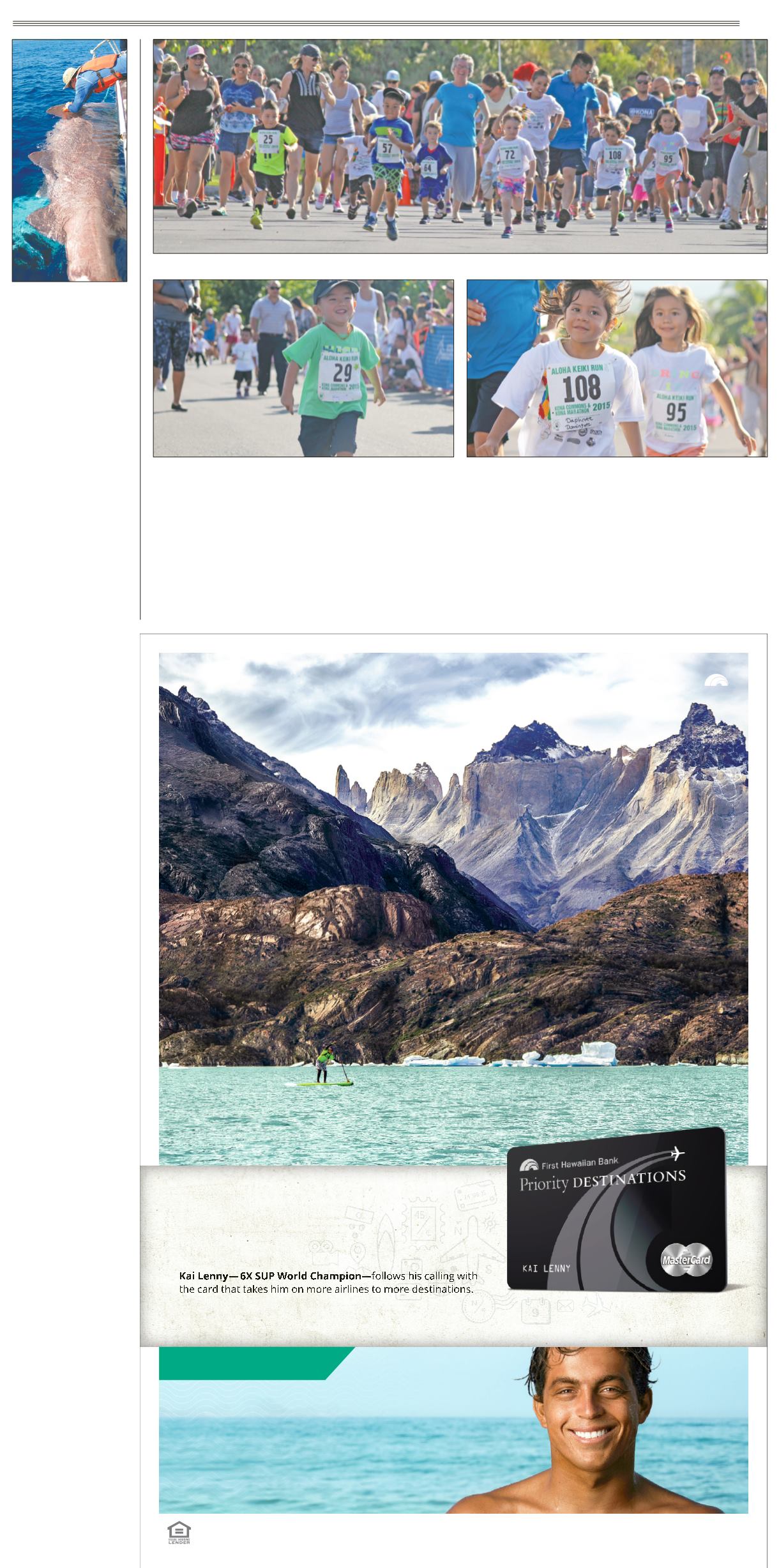
11A
WEST HAWAII TODAY | SUNDAY, JUNE 21, 2015
The device measured
the shark’s speed, head-
ing, orientation and tail
movement, finding that
the deep divers are able to
glide upward for several
minutes at a time without
moving.
“We didn’t expect to
find evidence of pos-
itive buoyancy, and ran
two sets of experiments
to confirm our initial
observations of this phe-
nomenon. This finding
was a total surprise,”
said Carl Meyer, assis-
tant researcher at UH
Manoa’s Hawaii Institute
of Marine Biology.
Meyer thinks the pos-
itive buoyancy may give
the hunters added stealth
as they glide upward,
motionless, to nab prey.
Or it may help the sharks
make their nightly migra-
tions to shallower areas.
Meyer said that cam-
eras will hopefully cap-
ture footage of the
sharks feeding, and more
research will hopefully
shed light on many unan-
swered questions about
the denizens of the deep.
“When I first down-
loaded
the
camera,
I thought it had failed
because all I saw were
thousands of completely
black frames,” said Meyer.
“Suddenly a string of
images appeared with a
brightly-lit, alien-looking
reef and strange deep-
sea invertebrates. I was
elated and realized that
the black frames result-
ed from the shark swim-
ming around too high in
the water column for the
camera strobe to illumi-
nate the seabed.”
The animals typical-
ly range from 600 to
2,000 feet deep around
Hawaii. Most of the
deep-sea sharks here
are smaller to medium
sized species — gulpers,
kitefins, black-bellied
lantern sharks and false
catsharks. The gigantic
Pacific sleeper shark like-
ly lives in Hawaii waters
also.
“There is also a very
good chance that other
deep sea sharks exist
around Hawaii, but we
just haven’t discovered
them yet,” Meyer said.
“We would like to equip
some of these other spe-
cies with accelerome-
ter devices to determine
whether they also exhibit
positive buoyancy.”
Researchers caught the
sharks off Kaneohe, Oahu
using baited hooks set
1,000 feet blow the surface.
Hauled into bright, unfa-
miliar surface waters that
are 20 to 40 degrees warm-
er than what the sharks
are used to, the animals
had to be quickly tagged
and returned, Meyer said.
The sharks resumed their
natural behavior once they
swam back to their deep
sea habitat, he said.
SHARKS:
Cameras will
hopefully capture
footage of the
sharks feeding
CONTINUED FROM PAGE 1A
Researcher Carl
Meyer attaches an
accelerometer package
to the pectoral fin of a
15-foot, 1,200-pound
sixgill shark.
STEVE KAJIURA/
SPECIAL TO WEST HAWAII TODAY
which was presented by Kona
Marathon.
The youngest athletes, ages
1-4, ran a 100-yard dash, the 5-6
age group did a 200-yard dash,
and the 7-8 year olds completed
a 440 yard run. The older age
groups did a 1 ½-mile run (9-10)
and the 11-15 group closed out
the day with a full 1-mile.
All entrants receive a t-shirt,
finisher medal, and goodie bag
Away from the competition
there was much fun to be had.
Ronald McDonald and Shrimp
Louie — mascot of Bubba
Gump Shrimp Company —
entertained and cheered on
the young athletes, and a giant
waterslide cooled down the
runners after the race.
Many local organizations put
on booths and helped with the
race, making it a very family-
focused, community driven
event.
“We started out over at Hale
Halawai with about 60 kids,
and now we are close to having
400 crossing the finish line.
Plus we have all the parents
and other relatives that came
out to support them,” said Race
Director Sharron Faff. “We are
really thrilled about having
everyone involved with this race.”
The Kona Marathon is June
28 at Waikoloa Beach Resort.
KEIKI:
Many local organizations put on booths and helped with the race
CONTINUED FROM PAGE 1A
Keiki athletes participate in the 7th annual Aloha Keiki run on Saturday.
PHOTOS BY J.R. DE GROOTE/
WEST HAWAII TODAY)
MOR E CHO I CE S . MOR E FR E EDOM.
Member FDIC
Subject to credit approval. Apply for the personal Priority Destinations
®
World Elite credit card and, if you’re approved, receive 5 Priority Miles
®
per $1 spent on net qualifying travel purchases up
to $6,000 per calendar year, and 2 Priority Miles per $1 spent on travel purchases thereafter; 2 Priority Miles per $1 spent on qualifying everyday purchases (gas, grocery, cable TV, phone and
other monthly utilities); and 1 Priority Mile for every $1 spent on all other net qualifying purchases. Travel and booking subject to availability. Additional fees and restrictions apply. See the Priority
Destinations World Elite Program Agreement for more information. First Hawaiian Bank reserves the right to cancel or change the Program at any time without prior notice.
PriorityDestinations.com
“WHERE THE TRAIL ENDS,
I BEGIN.”
5X MILES
ON TRAVEL PURCHASES.


